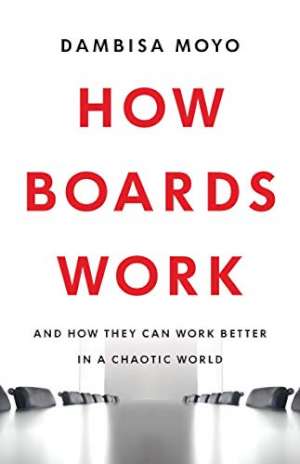15 July 2021
How Boards Work:
and how they can work better in a chaotic world
Dambiso Moyo
2021, Little, Brown Book Group, 305 pages,
ISBN 9780349128382
Reviewer: Dame Kate Barker, NED, Man Group plc

To outsiders, there can be an air of mystery around what happens in boardrooms. Based on a wide range of board experience, across multiple sectors and different countries, Dambisa Moyo sets out to open up board work. The title page lists a range of intended audiences – from aspiring board members to politicians, regulators and the general public. The overarching aim is to illustrate why, given that successful and well-run companies are vital to our economies, what happens in board rooms really matters.
My own experience of boards is less wide-ranging – though I have served on the boards of three plcs and one building society. One of Moyo’s early comments certainly chimed home – if you are thinking of joining a board, ask yourself: ‘which member of the management team would call me for advice, and why?’. Board members need to justify their roles, although often it is an unexpected turn of events that suddenly makes an expertise relevant. And board experience in itself becomes a transferable skill.
The key roles of a board are well-described – focusing on strategy, CEO selection and renewal of the board itself. Strategy has to come first from the executive, but the board should play an important role of supportive challenge. This means an element of tension, and will only work well if there is mutual trust – a board where that starts to fray will not be effective. My own experience suggests that a difficult thing for an NED is working out which of the questions that occur to you should be pursued, and when you need to back off.
Choosing the right CEO is a vital task, and requires both a good cultural fit and consideration of the challenges the company needs to address. Boards also need to be clear about how they judge a CEO’s performance, recognising their own role in setting strategy. More generally boards are increasingly concerned with company culture and Moyo points out that different companies will want to have different cultures, although some features, such as openness, will be common to all.
The meat of the book tackles the range of issues which are coming up board agendas. Most obviously there is now more focus on corporate behaviours which are socially acceptable as public expectations of companies change and investors respond to this by looking harder at the ESG considerations which they believe will drive long-term performance. Despite this investor pressure for short-term profits frequently continues. Balancing short-term profits, dividend policy, company resilience and stakeholder concerns faces boards with complex choices.
In the corporate governance arena, debate has recently become dominated by executive remuneration – and I can attest to the fact that a great deal of board member time now tends to be devoted to the pay of a small number of individuals. While I’ve been a remuneration committee member in the UK, shareholder views on executive pay has shifted from looking for a clear focus on shareholder returns to a welcome and more balanced focus on some of the ‘softer’ attributes (how the company handles diversity, treats its suppliers, etc).
Looking at the global trends swirling around companies, she suggests boards should be thinking about the implications of: a more siloed and protectionist world; changes in what investors want from companies and investor behaviour; faster technological change; the global war for talent; and, short-termism.
Moyo finally makes a number of proposals for reform. She argues boards need to keep a strong focus on long-term strategy, perhaps working more closely with management. NEDs should also ensure they have sufficient challenge of management data and hear external views on industry trends. The search for the CEO may need more focus on their moral compass, and boards themselves need to work on their own diversity. Boards should consider setting up an ethics committee. Most importantly, boards must be alert to the need for fresh ideas and ensuring they are taking the decisions that will best prepare the company for the future.
This is an interesting book for those wanting to know more about boards, though perhaps does not produce a great deal which would be new for a seasoned NED. But it does contain a rallying call in stressing the importance of good board leadership which has its eye on the long-term.
